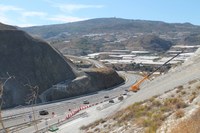Granada: Stabilize another slope of the A-7 to avoid more landslides
PILAR GARCÍA-TREVIJANO LÚJAR.
On April 27, the Ministry of Transport, Mobility and Urban Agenda (Mitma) partially restored traffic on the A-7 after a landslide, which occurred on March 11, forced the cutting of all four lanes and diverted traffic during 12 kilometers along the old National 340.
The landslide, which occurred near Gualchos-Castell de Ferro, was not the first to affect the road that connects Malaga, Granada and Almería. But it is one of the most serious. The landslide left the highway completely buried. The operators worked day and night to access the center of the collapse and reopen the highway. The ministry began to stabilize the slope that suffered the landslide, lowering the hill to eliminate the unstable areas in order to stop the landslides on the road, which were continuous and forced to impede traffic between kilometers 342 and 354. At that time then, the UGR began to warn that the hill in front of the area that collapsed was in the same danger. The geologists informed the technicians, who verified that the scientists were not mistaken and decided to put their hands on the matter.
The ministry has underway the works for the complete stabilization of the slope. The hill coincides with the Espinar area, which is part of the municipality of Lújar. According to Mariano González, the first mayor of the town, the ministry has piloted the mountain to prevent it from collapsing. In this way the hill will be contained and farmers will not have to fear for their farms. The mayor maintains that the works will be completed in the coming weeks and finally all traffic on the highway will be restored.
Right now there is a section of about 500 meters in the right lane in the direction of Malaga, just at the exit of Gualchos-Castell de Ferro, which is cut while the machinery stabilizes the slope. In addition, the mayor of the coastal town explains that the section that was affected by the landslide has also been resurfaced.
With these actions, the agricultural exploiters trust that they can breathe easy. They, too, had been warning for years of the erosion of the hillside. Some had even suffered the consequences of the landslides in their own flesh. In April 2020, just a year before the adjoining hill collapsed over the highway, a small landslide destabilized several farms and forced the road that gave access to 300 fields in the Espinar area to be cut off. Roberto García's greenhouse stayed on the edge of the cliff and hopes that the earth under his feet does not move again.
Planned tunnel
“There is not supposed to be a landslide, but just in case I'm going to pray that it doesn't rain too much. As soon as the ground was soaked, we were sold. Now this place is desert and that has meant that the hill has not collapsed so much. In 2009, when land was expropriated from me to build the highway, a tunnel was planned between the two slopes, which have been affected by the landslides. That tunnel, which would hold the hills, was not built in the end and look at everything that has happened, ”says García.
For their part, the group of scientists who began to study the slopes will continue their research once the stabilization work is complete.
The researcher from the Geodynamics department of the UGR, Jorge Pedro Galve, has closely followed the conditions of the hills. Geologists carried out a topographic survey by scanning the slope with a laser, and took pictures with a drone. The data collected has made it possible to develop three-dimensional models with which it has been possible to cubed volumes and study the evolution of the detachment. Galve says that the volume collapsed on the road was 10,000 square meters, in addition to at least another 20,000 that excavated the machinery. Technicians removed 1,200 cubic meters of soil daily. The UGR provided the operators with images and topographic surveys to facilitate their work. The ministry estimates that around 40,000 cubic meters of earth was excavated, which is equivalent to the capacity of ten Olympic swimming pools.

